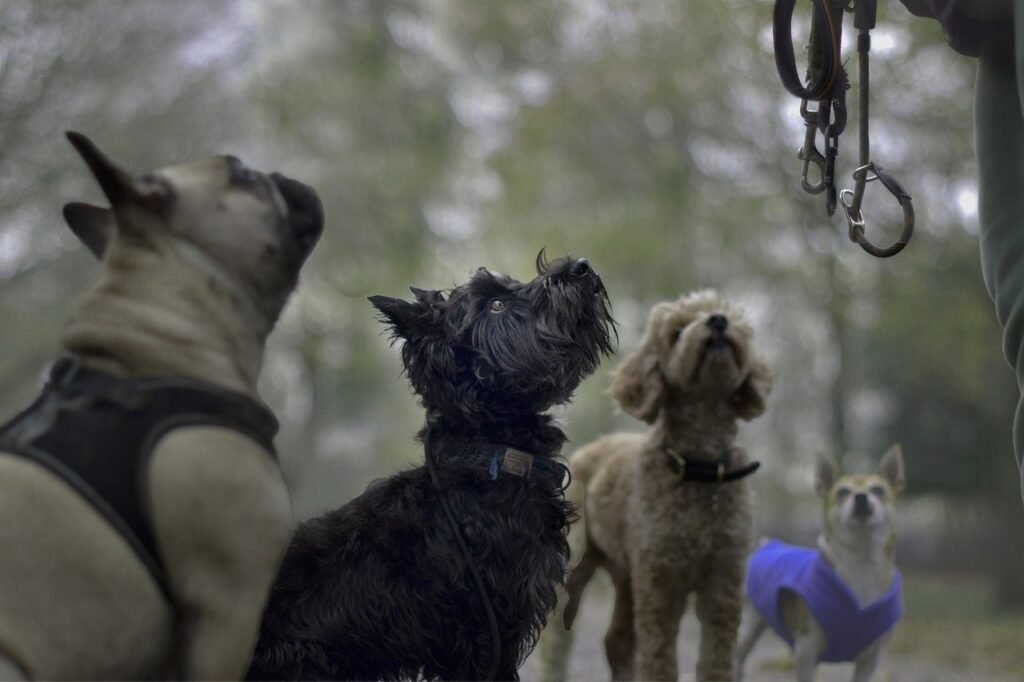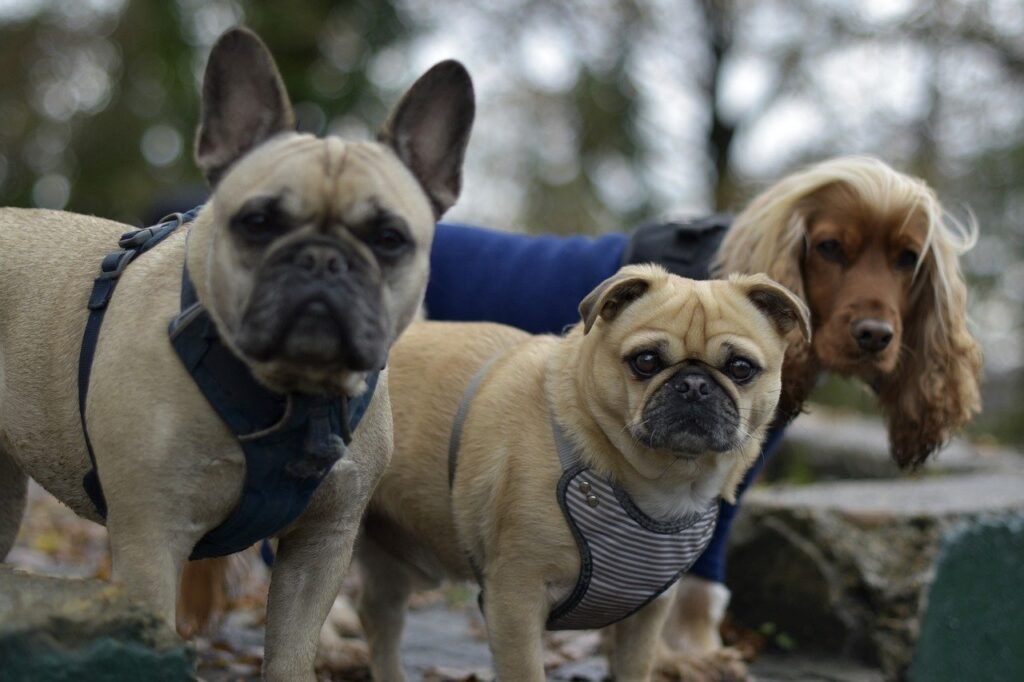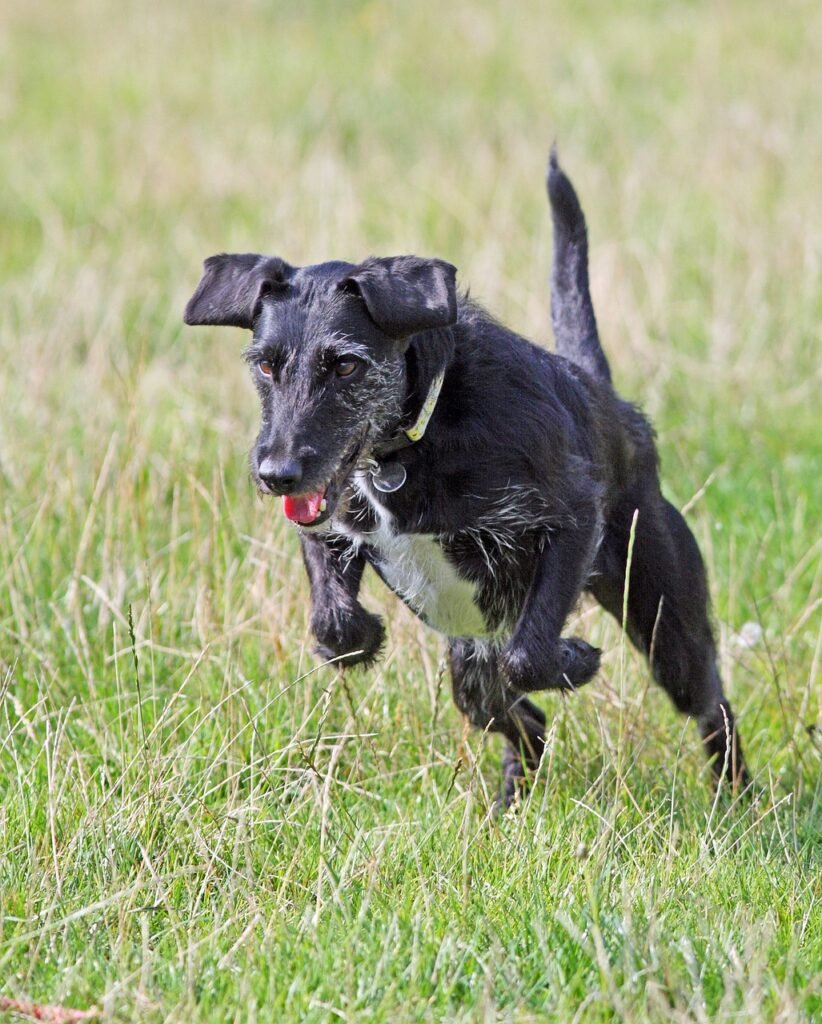Intro
As our beloved furry friends age, it’s crucial to adapt their exercise routines and activities to meet their changing needs. Senior dogs require specialized care to ensure they remain healthy, happy, and engaged. In this blog post, we will explore the importance of senior dog exercise and mental stimulation, providing you with practical tips and ideas to keep your aging pup thriving.
Understanding Your Senior Dog’s Changing Needs

Navigating the journey into your dog’s senior years requires a gentle, attentive approach, especially when it comes to recognizing the shifts in their physical and cognitive capabilities. As dogs progress into their golden years, it’s not uncommon for them to encounter hurdles such as reduced mobility, lessened stamina, and even a decline in cognitive function. These changes necessitate a thoughtful reassessment of how we engage with our aging companions to ensure their continued happiness and well-being.
Observing your senior dog closely will reveal subtle cues that indicate it’s time to adjust their routine. Perhaps they’re slower to rise in the morning, or maybe they seem less enthusiastic about activities that once thrilled them. These are signals that it’s time to reevaluate their exercise and mental stimulation routines. Embracing low-impact exercise options and incorporating gentle, yet engaging, mental stimulation activities become pivotal in maintaining their quality of life.
Understanding the specific health challenges your senior dog faces is key to providing the best care. Conditions such as arthritis can significantly impact their mobility, making once enjoyable long walks less feasible. Similarly, cognitive changes can affect their behavior and ability to engage in complex tasks. By recognizing these shifts, you can tailor activities that accommodate their current abilities without compromising their safety or comfort.
Collaborating with your veterinarian is an essential step in this process. They can offer invaluable insight into your dog’s health status and recommend modifications to their diet, exercise, and mental stimulation plans that align with their age-related needs. This partnership ensures your senior dog receives a holistic approach to care that encompasses all aspects of their health.
Adapting to your senior dog’s changing needs isn’t just about modifying physical activities; it’s also about nurturing their spirit and continuing to provide them with a sense of purpose and joy. Simple adjustments to their routine can make a significant difference in their overall happiness. Whether it’s shorter, more frequent walks or engaging in low-energy games that stimulate their mind without taxing their body, the goal is to keep them active and content.
In embracing these changes, you’re not just caring for a senior dog; you’re honoring a lifetime of companionship, loyalty, and love. Recognizing and adjusting to your senior dog’s evolving needs is a testament to the deep bond you share, ensuring their golden years are filled with comfort, joy, and the dignity they deserve.
The Benefits of Gentle Exercise for Aging Canines

Incorporating gentle exercise into the daily routine of your aging canine friend can open the door to numerous health benefits that extend far beyond simple physical fitness. Low-impact activities, such as leisurely strolls through the neighborhood or brief sessions of tug-of-war, can significantly enhance joint health by promoting flexibility and reducing the stiffness often associated with conditions like arthritis. This form of exercise gently encourages movement without overburdening your senior dog’s body, making it an ideal choice for their delicate condition.
Not only does gentle exercise bolster physical health, but it also plays a crucial role in mental wellness. Regular, light physical activity stimulates the mind, keeping your furry companion alert and engaged. This stimulation is especially beneficial for warding off the cloud of cognitive decline, ensuring that your dog’s mental faculties remain sharp. By intertwining physical movements with cognitive challenges, such as navigating new routes on walks or learning simple, low-stress tricks, you provide a comprehensive workout that touches both body and brain.
The impact of gentle exercise extends to emotional health as well. Dogs are creatures of habit and purpose; thus, maintaining a routine that includes physical activity can significantly uplift their spirits. The sense of normalcy and accomplishment they gain from completing these exercises contributes to a positive emotional state, combating feelings of isolation or neglect that can sometimes affect senior pets. The joy and excitement they exhibit during these activities serve as a testament to their enduring zest for life, regardless of age.
Furthermore, engaging in regular, gentle exercise with your senior dog fosters a deeper bond between you two. This shared activity time is not just about keeping them physically fit; it’s an opportunity to communicate your love and commitment to their well-being. Each step taken together strengthens the connection you share, providing comfort and assurance to your aging companion that they are not alone on this journey.
By prioritizing gentle exercise, you’re not only catering to the physical needs of your senior dog but also enriching their overall quality of life. The multitude of benefits it offers makes it an indispensable component of caring for an aging canine, ensuring their golden years are as golden as can be.
Tailored Exercise Options for Your Senior Dog

Crafting the perfect exercise regimen for your senior dog is like creating a bespoke suit—it needs to fit just right, accounting for their unique health conditions, energy levels, and preferences. Begin by considering activities that keep your dog moving at a comfortable pace, without pushing them too far. For some, this might mean meandering walks in a serene park, where the sights and smells can keep their senses engaged as much as their legs. For others, gentle indoor games that encourage mild stretching or balance, such as hiding treats under cups for them to find, can provide both physical and mental engagement without the strain.
Diving deeper into low-impact exercise, water therapy stands out as a stellar option for dogs with arthritis or hip dysplasia. Swimming, or even just wading in shallow water, allows for muscle engagement and cardiovascular work without the harsh impact on joints that comes from more traditional exercise. If you’re unsure where to start, look into canine hydrotherapy services that can guide you through the process with professional oversight.
On days when the weather or your dog’s energy levels don’t permit outdoor adventures, consider interactive toys that move unpredictably, mimicking the chase of prey. These toys can stimulate your dog’s mind and encourage light physical activity as they engage in the age-old dance of predator and prey, all within the comfort of home. Similarly, teaching your dog new, low-energy tricks or commands can keep their brain sharp while respecting their physical limitations.
Balance exercises are another golden nugget for senior dog care. Simple activities, like standing on a wobble board or walking over a cushioned surface, can improve your dog’s proprioception—awareness of body position and movement—which often declines with age. This form of exercise not only aids in physical health but also boosts confidence and spatial awareness.
Remember, the key to a successful exercise routine for your senior dog lies in customization and adaptation. Regularly assess how they’re responding to their activities, and don’t hesitate to make adjustments. Engaging your senior dog in tailored exercise is not just about maintaining their physical health; it’s about enriching their golden years with joy and fulfillment.
Mental Stimulation: Why It Matters for Your Senior Dog

Engaging the mind of a senior dog goes beyond mere entertainment; it is a critical component of their overall well-being. Just as humans benefit from mental exercises to keep our minds sharp as we age, so too do our canine companions. Cognitive stimulation for senior dogs can significantly slow the progression of cognitive decline, helping them maintain a keen sense of awareness and responsiveness to their surroundings. It’s about nurturing a vibrant spirit within them, even as their physical capabilities may wane.
In the journey of aging, a dog’s enthusiasm for physical play may diminish, but their desire to explore and interact with the world does not. By introducing a variety of brain games for aging dogs, you offer them an outlet for their curiosity and a way to keep their minds agile. Puzzles that reward with treats or toys that require problem-solving skills can provide a sense of accomplishment and purpose. These activities not only stimulate their neurons but also reinforce the bond you share, as you guide and cheer them on through each challenge.
Moreover, mental stimulation acts as an invaluable tool in managing behaviors that might emerge with age. Senior dogs can develop anxiety or exhibit signs of confusion as part of their cognitive changes. Through engaging senior dog activities that require focus and thought, you can help mitigate these issues, providing a calming and reassuring routine that anchors them to the familiar and the manageable.
It’s also worth noting that mental exercise can be incredibly versatile, easily tailored to fit within the confines of your dog’s physical limitations. For instance, scent work leverages a dog’s natural olfactory skills, offering cognitive stimulation without demanding extensive physical exertion. This form of enrichment taps into their innate abilities, encouraging them to use their noses in a way that’s both mentally rewarding and physically gentle.
As we consider the holistic care of our senior dogs, integrating cognitive stimulation into their daily lives stands as a testament to our commitment to their happiness and longevity. By prioritizing these mental exercises, we pave the way for our aging companions to lead fuller, more engaging lives, every day.
Easy and Engaging Mental Stimulation Activities

Crafting a stimulating environment for your senior dog can be both rewarding and enjoyable, offering them the mental challenges they need to stay sharp. Start by sprinkling treats around your home for a fun scavenger hunt that not only gets their nose working but also their brain. This simple activity taps into their natural foraging instincts, providing a satisfying and enriching experience.
Introducing new commands or refreshing old tricks is another excellent way to keep your senior dog mentally engaged. It’s never too late to teach an old dog new tricks, and doing so can reinforce your bond while keeping their cognitive functions active. Whether it’s a simple ‘shake paw’ or a more complex ‘roll over’, the process of learning keeps their mind nimble.
Investing in puzzle toys can transform treat time into an intriguing challenge. These toys, designed to stimulate a dog’s problem-solving skills, require them to think critically and strategize to access their coveted treats. The mental exertion involved in these games makes them a fantastic option for indoor stimulation, especially on days when physical activity needs to be limited.
Exploring activities like scent work can offer a low-impact way to engage your dog’s mind and nose. By hiding a favorite toy or treat and encouraging your dog to find it, you’re providing a mentally stimulating game that plays to their innate sniffing abilities. This type of activity can be especially rewarding and engaging for senior dogs, giving them a sense of purpose and accomplishment.
By weaving these simple yet effective mental stimulation activities into your senior dog’s routine, you ensure they continue to lead a mentally active and fulfilling life. Each of these activities offers a unique way to challenge and engage your aging companion, proving that mental agility can indeed flourish with age.
Crafting a Weekly Routine for Balanced Care

Designing a well-rounded weekly routine for your senior dog is akin to crafting a masterpiece that balances their physical and mental needs. Start by penciling in daily walks, tailored in length and intensity to match your dog’s capabilities. These outings shouldn’t just be about physical exercise but also opportunities for sensory enrichment, allowing your dog to sniff and explore at their own pace.
Incorporate specific days for focused mental stimulation, such as puzzle-solving Tuesdays or scent work Thursdays, to keep their minds sharp and engaged. This variety ensures that each day offers something unique, keeping boredom at bay and maintaining your dog’s interest in life around them.
On weekends, consider dedicating time to more interactive activities that strengthen your bond, such as a gentle game of fetch with a soft ball or a training session revisiting old tricks. These moments of connection are priceless, offering emotional support alongside cognitive engagement.
Balance is key, so remember to intersperse these activities with plenty of rest and relaxation. Senior dogs value their downtime, and it’s crucial for their recovery and well-being.
Lastly, be prepared to flexibly adjust this routine based on how your dog is feeling. Some days they might be brimming with energy, eager for an extra-long stroll, while on others, they may prefer a quiet day indoors. Tuning into and respecting these fluctuations is essential for a truly balanced care plan that honors your senior dog’s individual needs.
Monitoring and Adjusting Activities as Needed

Keeping a watchful eye on how your senior dog reacts to their daily activities is crucial for their ongoing well-being. Observing their behavior during and after exercises can give you valuable insights into their comfort levels and enjoyment. If you notice signs of hesitancy before a planned activity or an increase in fatigue afterwards, it may be time to consider a gentler alternative or shorter sessions.
Adapting to your senior dog’s needs means being flexible with their routine. There will be days filled with vigor, where a little extra time outside brings immense joy, and others where rest is plainly their preference. Being attuned to these shifts ensures that your care aligns with their current state of health and happiness.
Consultation with a veterinarian is an indispensable part of this process. Should your observations raise concerns—perhaps a newfound reluctance to engage in activities they once loved—it’s essential to seek professional advice. Your vet can help pinpoint the cause and suggest modifications to their routine or diet that might restore their enthusiasm for exercise and play.
At the heart of these adjustments is your unwavering commitment to your senior dog’s quality of life. Each small change you make in response to their feedback is a step toward ensuring their golden years are filled with as much joy and comfort as possible. It’s about listening, adapting, and continuing to provide the love and care they’ve always known.
The Role of Diet and Nutrition in Supporting Senior Dog Activities

Crafting the ideal diet for your senior dog is akin to providing the fuel they need to thrive, not just survive, in their golden years. A well-balanced, nutrient-rich diet tailored to their age and health requirements can significantly amplify their ability to participate in both physical and mental activities. Just as a car runs smoother on high-quality gasoline, your senior dog’s energy and mobility are enhanced by the right food choices.
Incorporating specific supplements into your senior dog’s diet can be a game-changer for their overall well-being. Ingredients like glucosamine are known to support joint health, making those gentle walks or swims more comfortable. Similarly, omega-3 fatty acids have been shown to aid in cognitive function, ensuring their minds remain as active as their bodies.
Moreover, the selection of senior-specific dog food formulations can help manage weight, an essential aspect of keeping older dogs agile and ready for activity. These foods are designed to provide optimum nutrition while avoiding unnecessary calories, which is crucial for preventing obesity and its associated health risks.
Ultimately, the correlation between a thoughtfully chosen diet and your senior dog’s activity level cannot be overstated. By focusing on nutrition that supports both the body and the mind, you’re setting the stage for a richer, more vibrant life for your cherished companion in their later years.
